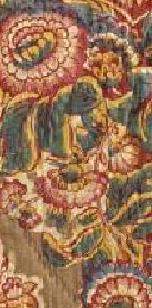
Excerpts from *
Cotton is a cellulose fiber with molecules shaped
unlike the carbon-based protein molecules of natural dyes. So, they do
not attract each other naturally. Wool and silk molecules are liked
shaped and do not require the help of mordants to produce colorfast
results.
The early dyers believed that adding animal
proteins to the dye mix would help the penetration of the dye into the
cotton. "Animalizing," as it was called, meant adding one or
more of the following: urine, blood, milk, dung, or egg albumen. Turkey
Red, a highly valued rich, deep, brilliant red dye for yarns and fabric,
was known to use blood, dung, and urine in the dyeing process, and it
was extremely colorfast. Glancing through the back pages of old recipes
for dyers, one may find a recipe for beer…where urine was needed, beer
stimulated (shall we say) a quick source of supply. Eventually it was
recognized that animalizing proved insufficient in obtaining
colorfastness. Yet "dunging" continued to be used for the
removal of extraneous mordant until well into the 19th century, and egg
albumen continued to be used as a binder for pigment dyes.
Mordants were the answer. There are many different
kinds of mordants, but the main ones used in dyeing cotton prints were
mineral salts: aluminum, iron, tin and copper. Alum was the most widely
used, as it helped get shades of red and rust from madder. Iron was also
used a lot, with madder, logwood or by itself, to darken or dull colors
and to produce blacks and dark browns. Tin gave an extra brightness to
reds, oranges and yellows, and it resisted iron, which was a plus when
using the multiple dyes. The least mentioned mordant seems to be copper,
which was less harsh on cotton than tin, but could still be harsh. It
brought out green tones, and darkened dyes, generally. An analogy of
mordant dyeing would be a bridge over water. The mordant forms a bridge
between the dye and the cotton, enabling the dye to travel into the
molecule and bond with it . . .
 Many
reds, pinks, rusts, browns and purple dyes came from the root of the
madder plant . . . Many
reds, pinks, rusts, browns and purple dyes came from the root of the
madder plant . . .
Colors produced from mineral dyes include Prussian
blue, manganese bronze, chrome yellow, orange, blue, or green, antimony
orange, iron buff and teal green. There were two ways these pigment
colors could be fixed to cotton. Early on, egg albumen was used as a
binder for lighter colors, and blood was used for the darker colors.
Gluten from wheat and lactarine from milk were other binders, but all
binders needed heat and an acid to make them colorfast. Ultramarine blue
was made in this manner. In the other method, the pigment was printed
directly onto the fabric and then passed through a second dyebath,
usually of potassium or alkali, to cause a chemical reaction between
them on the surface. For example, chrome orange was produced when chrome
yellow was passed through an alkaline treatment, and Prussian blue came
from iron and potassium . . .
The primary method of Indigo dyeing was called
vat dyeing. A vat is a chemically reducing dyebath . . .
Simply adding more dye to the bath would not produce a darker shade of blue. It
required repeated submerging followed by oxygenation. If an area were to remain
white it would be covered with a resist paste made of wax or wheat, to keep the
dye from penetrating in . . .
Eventually, stable direct printing of indigo was possible in the last quarter of
the 19th century. Glucose utilized indigo in such a way that the reduced version
combined with steam would fix the color. German scientist, Bayer, first
synthesized indigo in the 1880s, patenting it in the early 1900s. Commercial
dyeing with synthetic indigo didn't begin until 1897. It essentially replaced
the use of natural indigo by the early 1920s . . .
* For complete article and pictures, click on:
Vintage
Fabrics - IN SEARCH OF WARP ENDS. Found
at: http://www.fabrics.net/joan1002.asp
|